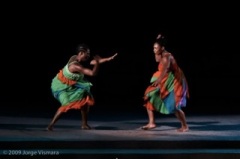By Mary Verdi-Fletcher, Dancer-Client & Caroline H. Newhouse recipient
As America’s first professional wheelchair dancer, I have spent nearly all of my adult life dancing, teaching, and promoting the concepts of physically integrated dance: the partnering of stand up and sit down (wheelchair) dancers. For 32 years I have traveled the globe with my Company, Dancing Wheels, reaching over 5 million people with and without disabilities, and although I still dance and direct my Company, I have long looked for ways to continue my work into my retirement years.
Several years ago, I proposed the idea of a manual and DVD to my associate and artistic advisor, Mark Tomasic. Mark took on the daunting task of writing this manual as part of his master’s thesis at the University of California, Irvine. Together we mapped out the process of gathering research and data based on the physical benefits of dance for wheelchair users, the Dancing Wheels methods of training, and the outcomes of choreography as they relate to this art form. We then approached several organizations to help us make this document available to the public. Career Transition for Dancers came forward with support for the publishing and replication of these important educational tools. As a result of their support, the manual and DVD was unveiled on October 26th at a major event in Cleveland celebrating Disability Awareneness Month, and is available online at www.dancingwheels.org/order.asp. The manual which is entitled Physically Integrated Dance Training: The Dancing Wheels compressive guide for teachers, choreographers, and students of mixed abilities, will open the doors of opportunities for university dance departments, rehabilitation centers and individual artists as a vehicle by which to teach this new dance form. It will broaden the scope of dance and allow for employment opportunities for choreographers, dance teachers, and dancers. And for me, it will allow me to pass on my lineage and to relay the message of integrated dance world-wide!





